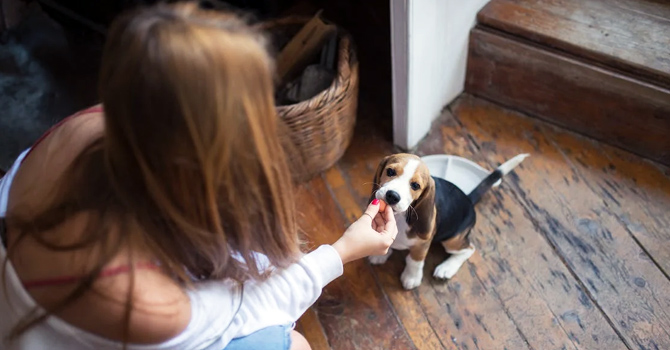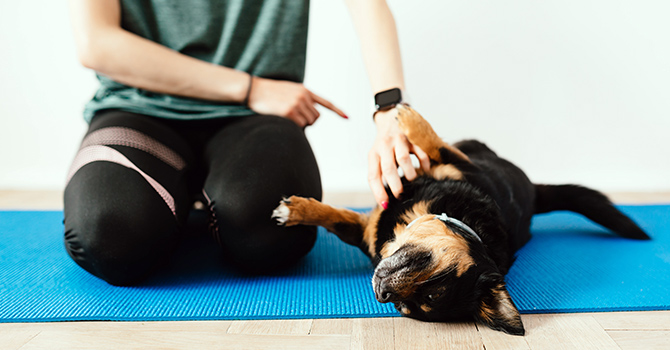Dog Training Tips for Beginners
July 27, 2023 in Dog Training Tips | No Comments

As a new dog owner, embarking on the journey of training your furry companion can be both exciting and rewarding. Dog training is not just about teaching your dog basic commands; it lays the foundation for a harmonious relationship and a well-behaved pet. Building a strong bond with your dog is crucial for effective training and hence, it is recommended to take Dog trainer classes. A close connection fosters trust and communication, making it easier to teach new skills and correct undesirable behaviours. Understanding the basics of positive reinforcement is a key component of successful training. Reward-based techniques encourage good behaviour and create a positive learning experience for your canine friend.
How to Prepare for Training?
A. Creating a dog-friendly environment sets the stage for effective learning. Remove potential hazards, designate a safe space, and ensure your dog has access to food, water, and rest areas during training sessions.
B. Choosing the right training method tailored to your dog’s personality is essential. Some dogs respond better to gentle encouragement, while others may benefit from more structured approaches. Understanding your dog’s temperament will guide your training approach.
C. Gathering essential training supplies, such as treats, a clicker (if using clicker training), a leash, and toys, ensure you’re equipped for productive training sessions.
Basic Commands for dog training
A. Teaching your dog to sit lays the groundwork for obedience. It’s a simple and basic command that helps control your dog’s behaviour in various situations.
B. The “stay” command is vital for safety and preventing your dog from wandering off or getting into dangerous situations.
C. “Come” is a crucial command, especially in emergencies or when you need your dog to return to you promptly.
D. Teaching your dog to “leave it” prevents them from picking up harmful or undesirable objects while on walks or at home.
E. “Heel” is essential for leash manners, ensuring your dog walks calmly by your side without pulling.
Positive Reinforcement Techniques for Beginners:

- Reward-Based Training Methods: Positive reinforcement is one of the most effective and humane ways to train your dog. This method involves rewarding desirable behaviours, making your dog more likely to repeat them in the future. Instead of focusing on punishing unwanted behaviours, reward-based training accentuates the positive aspects of your dog’s actions. Dog training institute will offer training courses that help you easily train your dogs and can get hands-on experience in basic training.
- Identify desirable behaviours: Determine the behaviours you want to reinforce, such as sitting, coming when called, or staying calm during greetings.
- Choose appropriate rewards: Find out what motivates your dog the most. Treats, toys, or verbal praise can be excellent rewards. High-value treats are particularly useful for more challenging commands or distractions.
- Timing is crucial: Deliver the reward immediately after your dog performs the desired behaviour. This helps your dog associate the reward with the action they just performed.
- Consistency: Be consistent in rewarding the behaviour you want to encourage. Reinforce the same behaviour every time, especially during the initial stages of training.
- Using Treats Effectively: Treats are a powerful tool in positive reinforcement training, but it’s essential to use them wisely to avoid overindulgence or dependency.
- Treat size: Use small, bite-sized treats to prevent overfeeding during training sessions.
- Varied rewards: While treats are a favourite, mix in other rewards like verbal praise and petting to keep your dog engaged and prevent boredom.
- Gradual fading: As your dog becomes proficient in a command, gradually reduce the frequency of treat rewards, transitioning to occasional reinforcement.
- Keep treats out of sight: Avoid displaying treats openly during training, as it can distract your dog from focusing on the desired behaviour.
- Verbal Praise and Encouragement: Alongside treats, verbal praise and encouragement play a vital role in positive reinforcement training. Your voice tone and enthusiasm can significantly influence your dog’s motivation to perform well.
- Use a cheerful tone: Dogs respond well to a warm and upbeat voice, making them feel appreciated and motivated.
- Be specific: Be clear and specific with your verbal cues. For example, use “good sit” or “great stay” to let your dog know precisely what they did well.
- Timing matters: Just like with treats, timing is essential with verbal praise. Offer praise immediately after your dog performs the desired behaviour.
- Affectionate gestures: In addition to verbal praise, gentle petting, and physical affection can reinforce your dog’s positive behaviour.
Important Eight tips to train dogs successfully for beginners

Patience and Consistency – Patience and consistency are the cornerstones of successful dog training. Training takes time, and each dog learns at its own pace. Be patient with your furry companion as they navigate the learning process. Consistency is equally vital; use the same commands and cues consistently to reinforce the desired behaviours. Avoid confusing your dog by changing the rules or commands. Repetition is key to cementing new behaviours, so practice regularly with patience, even if progress seems slow. The bond you build with your dog through patience and consistent training will lead to a more fulfilling and lasting relationship.
Establishing Consistent Routines: Dogs thrive in structured environments, so establishing consistent routines is essential for effective training. Set regular times for feeding, potty breaks, exercise, and playtime. Consistency creates a sense of security and predictability for your dog, reducing anxiety and unwanted behaviours. Stick to the routine, even on weekends or during busy periods. Avoid sudden changes to the schedule, as it can lead to confusion and setbacks in your dog’s training progress. A consistent routine will make it easier for your dog to understand and follow the rules, fostering a well-behaved and happy canine companion.
Avoiding Punishment-Based Training Approaches – Traditional punishment-based training methods, such as yelling, hitting, or using shock collars, have been widely discredited in recent years. Positive reinforcement, on the other hand, has proven to be highly effective. Use treats, praise, and affection to reward good behaviour, and ignore or redirect undesired actions. This approach fosters a stronger bond between you and your dog, making training a positive and enjoyable experience for both. Choose a positive and encouraging approach to training, and you’ll see more reliable and long-lasting results while building a trusting relationship with your furry friend. Dog training centers will help you practice training approaches without punishment.
Socialization and Exposure – Socialization is a vital aspect of dog training, especially for puppies. Early and positive exposure to various environments, people, and other animals helps dogs develop into well-adjusted and confident adults. Enrol your dog in puppy socialization classes, where they can interact with other pups and learn valuable social skills. Look for dog training academies or dog schools in your area that offer socialization programs.
Dealing with Common Challenges – During the training process, you may encounter common challenges like leash pulling, excessive barking, or jumping on people. These behaviours can be frustrating, but it’s essential to stay calm and address the root cause rather than just the symptoms. For example, leash pulling might be due to pent-up energy, so ensuring your dog receives sufficient exercise can be a solution. Research specific training techniques to tackle common challenges effectively.
Understanding Body Language – Learning to interpret your dog’s body language is crucial in understanding their emotions and needs. Dogs communicate primarily through body language, so being attuned to their cues can help you anticipate their reactions and adapt your training methods accordingly. Watch for signs of stress, fear, excitement, or contentment to ensure your dog feels safe and comfortable during the training process.
Training Games and Activities – Make training fun and engaging by incorporating games and activities into your routine. Dogs love to play, and turning training exercises into games will keep their interest levels high. Play fetch with recall training, hide treats for a game of “find it,” or teach tricks that challenge their minds. Remember to use positive reinforcement during these activities to reinforce good behaviour.
Seeking Help from a Professional Trainer – As a beginner, you might encounter difficulties that require expert guidance. Don’t hesitate to seek help from professional dog trainers or enroll in dog trainer classes or courses. A reputable dog training institute can provide valuable insights, personalized training plans, and hands-on experience that will boost your confidence as a trainer and enhance your dog’s learning journey.
Conclusion
Training your dog is a journey that requires dedication, patience, and a positive mindset. By establishing consistent routines, using positive reinforcement, and engaging in socialization activities, you can set your dog up for success. Remember to stay attuned to your dog’s body language and seek professional help when needed. With the right approach and plenty of love, you can build a strong bond with your furry friend that will last a lifetime.
If you are based in Kerala, then there are many dog school in Kerala that offer basic and advanced training including obedience training, and toilet training etc., Investing in your dog’s training is an investment in your relationship, and the rewards will be well worth the effort. Reach out to a Dog training academy in Kerala if you want to enroll in professional and effective training programs.